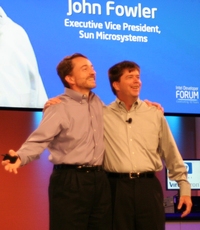Sun's new servers get intimate with Intel and Microsoft


Having this many number of drives in addition to 16 FBDIMMs in a 1U server is definitely unusual and impressive. The hard drives brackets had to be redesigned to push the drives back to allow plenty of air-flow to cool the two quad-core Intel 5300 series processors and 16 Fully Buffered DDR2-667 memory DIMMs. One of the three PCI-Express slots is loaded with a battery backed up RAID controller that allows worry-free write-back-cache operation to speed up write operations when using striping technology. Sun made it clear that despite the fact that Solaris uses ZFS which includes RAID-like redundancy features implemented in software, Sun was going to support the Windows, Linux, and Solaris world with hardware based RAID-0, RAID-1, RAID-5, RAID-6, RAID 1+0, and RAID 6+0.
One of the things a reporter asked at the launch event was why Sun wasn't supporting "embedded virtualization" like other server vendors. I had to contain myself since this is another one of those marketing slogans that make me roll my eyes. As I pointed out when I covered the 2U X4450, embedded virtualization is nothing more than a $20 USB stick shoved in to a port on the mother board booting the Hypervisor software and it's no different that a $300 PC booting off the USB port for the last couple of years. The 2U X4450 and the 1U X4150 both have internal USB slots you can insert a USB stick in to for booting anything under the sun including Hypervisors from any of the virtualization players. John Fowler had to thread the needle to answer politely but I'd suggest to him that he should explain that Sun does have the capability like everyone else in the future.
Another question asked from the audience is the appropriateness of these servers for HPC (High Performance Computing). This put Fowler in a tough position sitting next to Intel's Pat Gelsinger because this particular server with the Intel 5000 series "Bensley" chipset wasn't the best HPC platform in the world. Intel dominates on the general purpose server market benchmarks like SPECint_rate2006, SAP, SPECjbb2005, SPECweb2005, and TPC-C but not on high memory bandwidth HPC applications. Regardless of the fact that AMD might be exaggerating their lead by advertising scores from a non-existent model 2360SE processor not due until end of year and advertising an unlabeled processor in full page ads on the Economist, the current leader in the dual-processor HPC market is based on AMD's "Barcelona" Opteron 2350 which has the highest published score on SPECfp_rate2006 and a lower power consumption level. Fowler of course wasn't going praise AMD in an event with Intel so these servers were presented as good solutions for the HPC market. Sun does offer a 2U AMD 16-core equivalent to the X4450 (which I covered here) though it's not clear if Sun has a 1U dual-processor 8-core equivalent to the X4150 server.
I followed on with a question if Sun was going to follow on with a "Stoakley" platform (faster Inter chipset with Fully Buffered DDR2-800 FSB1600 support) with Harpertown (45nm Penryn server variant CPU) version of this server since the new platform and CPUs were due from Intel this November 12th. This question is very relevant to the previous question about HPC performance since Intel showed off SPECfp_rate2006 performance estimates at last week's IDF event that were even higher (chart below) than AMD's 2360SE product due at the end of the year.
Gelsinger jokingly told Fowler that he wanted to know when Stoakley was going to be put in to Sun's servers too but Fowler declined to discuss future product offerings but did say that the server platform was very flexible and that they wouldn't design it without future processors in mind. I spoke to Sun's engineer after the event and he explained that the power regulator was detached and modular and they could easily replace the motherboard and CPU with a Stoakley platform.